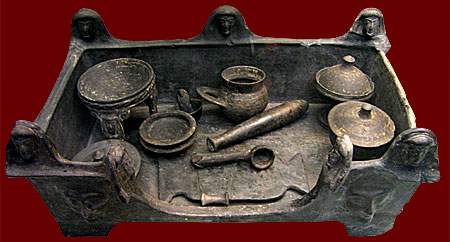 Etruscan funerary goods (6th century BCE) |
Vergil's famous epic poem in celebration of the
founding of Rome offers us
compelling portraits of goddesses and legendary women; none, however, capture
the feeling of lived existence like the unnamed simple housewife in this brief
simile, who rises before dawn to toil for her family. This glimpse into the
labor performed in the home by the traditional materfamilias serves as a
discreet bridge between the seduction by
Venus of her husband
Vulcan and his fulfillment of his
promise to forge powerful weapons for
her son,
Aeneas. But not until haud
secus (line 414) do we feel the impact of this image: while the two
subjects and their tasks could not be more different, through this comparison
Vergil makes us understand the dedication the divine metalsmith brings to his
task Both like and yet unlike, the simile portrays Vulcan's spirit not as the
work ethic of a skilled artisan but as the selfless and tireless devotion to
family of a nurturing matrona. The meter is
dactylic hexameter. |
| Inde ubi prima quies medio iam noctis abactae | ||
| curriculo expulerat somnum, cum femina primum, | ||
| cui tolerare colo vitam tenuique Minerva | ||
| 410 | impositum, cinerem et sopitos suscitat ignis | |
| noctem addens operi, famulasque ad lumina longo | ||
| exercet penso, castum ut servare cubile | ||
| coniugis et possit parvos educere natos: | ||
| haud secus ignipotens nec tempore segnior illo | ||
| 415 | mollibus e stratis opera ad fabrilia surgit. |
Click on the underlined words for translation aids and
commentary, which will appear in a small window. Close the small window after
each use. Click on the icon link
![]() to the right of the
poem for related images and information.
to the right of the
poem for related images and information.